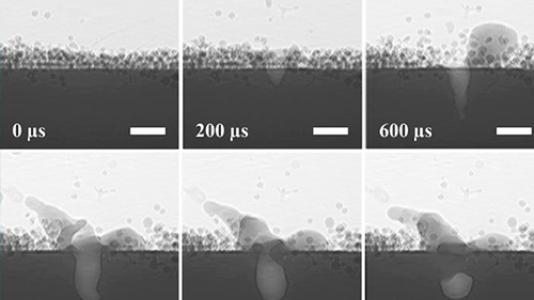
When considering new materials to make products lighter weight, faster, cheaper, safer and more efficient, understanding and being able to predict how these materials will behave is a critical first step. However, the process, often aided by computational modeling and simulation, is complex due to the nature of the materials. You need to understand not only how a material behaves normally but also what happens when it undergoes strain, temperature changes and other variations - insight that requires detailed data.
Argonne’s Advanced Photon Source, an Office of Science User Facility, can deliver this in-depth insight on material form and function. Alongside the thousands of users it helps every year, the APS has provided critical data to support modeling of third generation advanced high strength steel (3GAHSS).
The work, led by General Motors technical fellow Lou Hector, Jr., was part of a multi-institutional DOE-funded project that sought to create an Integrated Computational Materials Engineering (ICME) model of two 3GAHSS, high-strength, high ductility, lightweight candidates for mass reduction in vehicles.
“At the time we started the study, the steels of interest to the DOE did not exist in the commercial domain. But to build an ICME model, which accounts for microstructural processes that span several length scales, we needed data for calibration and validation,” Hector said. “This is where Argonne’s contribution turned out to be absolutely critical.”
X-ray imaging at the APS helped Hector and his collaborators measure and track martensitic phase transformation with strain in steel test samples. The data collected was used to develop and validate their material models, which were then used to make predictions for a vehicle body side structure.
A groundbreaking paper on their work garnered Hector, APS physicist Yang Ren, and seven other collaborators the prestigious AISI Institute Medal this May, in recognition of the merit and importance of their work in connection with the activities and interests of the iron and steel industry.
Another Approach for Materials - Additive Manufacturing
Turning advanced materials into useful components is as critical to synthesizing the materials themselves, and at Argonne, researchers are actively exploring ways to improve production methods. Among the methods they’re exploring is additive manufacturing, or three-dimensional (3D) printing, a suite of processes that build up parts by adding materials one layer at a time based on 3D computer models.
Compared with traditional manufacturing techniques that build by removing materials from a bulky chunk, additive manufacturing creates customized complex products by adding materials together with satisfactory geometric accuracy. It has many unique advantages, including more efficient use of raw materials, lower generation of hazardous waste, lower energy& consumption, shorter supply chain and reduced time to market.
Still additive manufacturing faces many roadblocks. Printed materials often contain structural defects and vary from their designs, forcing engineers to repair their finished pieces or start over from scratch. And not all physics behind the process are well understood. Much of the research in this area involves trial and error — a costly and time-consuming way to innovate.
To address these challenges, Argonne researchers are collaborating to investigate metal 3-D printing, including the material properties of the metal powders and how the laser “melts” and shapes those powders into the desired components, to discover both how defects form and methods to avoid them. Their work leverages APS X-rays, which enable them to peer deep inside materials formed by 3-D printing in real-time.
A team of researchers from Argonne, Carnegie Mellon University, and Missouri University of Science and Technology have shown that they can observe and quantify many metal 3-D printing characteristics— including melt pool size/shape, powder ejection, solidification, porosity formation and phase transformations.
Their finding can inform models used to reliably predict the characteristics of the printed materials and the dynamics of the process — such as how the laser melts the powder, when the powder changes into gases and liquids, and so on.
The experimental data feeds into models of additive manufacturing, and then the improved models are tested by more elaborate and insightful experiments, creating a virtuous loop. This interplay between modelers and experimentalists is essential to clearly and accurately understanding the underlying materials physics required to make 3D-printing truly reliable.
Argonne’s efforts will achieve the best of both worlds: Scientists will uncover the dynamic mysteries of metal additive manufacturing, while industries will thrive with blueprints to rapidly print cost-effective and reliable products.
“Our work will not only help industries improve efficiency and performance, but increase the likelihood that metal additive manufacturing will be more widely adopted in other applications,” Aaron Greco, a principal materials scientist at Argonne and project co-leader for Argonne’s additive manufacturing effort.
Evaluating 3-D printed parts
The ultimate proof of success in 3-D printing is observing 3-D printed parts functioning as well or better than non-printed parts in real world scenarios; Argonne researchers are evaluating their performance in the transportation domain.
Specifically, researchers at Argonne’s Center for Transportation Research have worked with Oak Ridge National Laboratory to develop and demonstrate a 3-D printed cylinder head can function and survive the harsh environments inside an engine.
A cylinder head, a complex engine part, seals the combustion process from one side. It also mounts things like the fuel injectors or spark plugs, and manages the airflow and exhaust flow in and out of the combustion chamber. Oak Ridge researchers printed multiple iterations of the part, and Argonne researchers evaluated its features and tested it on an engine.
“Among the unknowns of 3-D printing are the material characteristics, since the materials used in 3-D printing behave differently than the classical materials we’re used to dealing with,” said Doug Longman, section manager for combustion engine research. “Ultimately we want to see if there’s a way to use the different material characteristics to manage heat losses, as this could enable heightened efficiency down the road.”
Additive manufacturing work was performed at the Advanced Photon Source’s 32-ID-B beamline.
The collaborative project with Oak Ridge National Laboratory is sponsored by DOE’s Advanced Manufacturing Office.